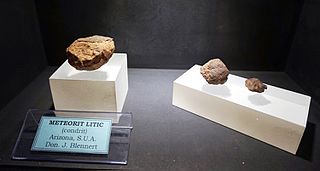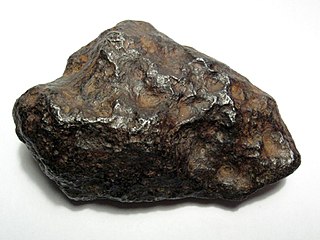
A meteorite is a solid piece of debris from an object, such as a comet, asteroid, or meteoroid, that originates in outer space and survives its passage through the atmosphere to reach the surface of a planet or moon. When the original object enters the atmosphere, various factors such as friction, pressure, and chemical interactions with the atmospheric gases cause it to heat up and radiate energy. It then becomes a meteor and forms a fireball, also known as a shooting star; astronomers call the brightest examples "bolides". Once it settles on the larger body's surface, the meteor becomes a meteorite. Meteorites vary greatly in size. For geologists, a bolide is a meteorite large enough to create an impact crater.

In meteoritics, a meteorite classification system attempts to group similar meteorites and allows scientists to communicate with a standardized terminology when discussing them. Meteorites are classified according to a variety of characteristics, especially mineralogical, petrological, chemical, and isotopic properties.

The S-IVB was the third stage on the Saturn V and second stage on the Saturn IB launch vehicles. Built by the Douglas Aircraft Company, it had one J-2 rocket engine. For lunar missions it was fired twice: first for Earth orbit insertion after second stage cutoff, and then for translunar injection (TLI).

AS-203 was an uncrewed flight of the Saturn IB rocket on July 5, 1966. It carried no command and service module, as its purpose was to verify the design of the S-IVB rocket stage restart capability that would later be used in the Apollo program to boost astronauts from Earth orbit to a trajectory towards the Moon. It achieved its objectives, but the stage was inadvertently destroyed after four orbits.

The Saturn IB was an American launch vehicle commissioned by the National Aeronautics and Space Administration (NASA) for the Apollo program. It uprated the Saturn I by replacing the S-IV second stage, with the S-IVB. The S-IB first stage also increased the S-I baseline's thrust from 1,500,000 pounds-force (6,700,000 N) to 1,600,000 pounds-force (7,100,000 N) and propellant load by 3.1%. This increased the Saturn I's low Earth orbit payload capability from 20,000 pounds (9,100 kg) to 46,000 pounds (21,000 kg), enough for early flight tests of a half-fueled Apollo command and service module (CSM) or a fully fueled Apollo Lunar Module (LM), before the larger Saturn V needed for lunar flight was ready.

J002E3 is an object in space discovered on September 3, 2002, by amateur astronomer Bill Yeung. Initially thought to be an asteroid, it has since been tentatively identified as the S-IVB third stage of the Apollo 12 Saturn V rocket, based on spectrographic evidence consistent with the titanium dioxide in the paint used on the rockets. The stage was intended to be injected into a permanent heliocentric orbit in November 1969, but is now believed instead to have gone into an unstable high Earth orbit which left Earth's proximity in 1971 and again in June 2003, with an approximately 40-year cycle between heliocentric and geocentric orbit.

Ataxites are a structural class of iron meteorites with a high nickel content and show no Widmanstätten patterns upon etching.
Meteoritics is the science that deals with meteors, meteorites, and meteoroids. It is closely connected to cosmochemistry, mineralogy and geochemistry. A specialist who studies meteoritics is known as a meteoriticist.

Iron meteorites, also known as siderites, or ferrous meteorites, are a type of meteorite that consist overwhelmingly of an iron–nickel alloy known as meteoric iron that usually consists of two mineral phases: kamacite and taenite. Most iron meteorites originate from cores of planetesimals, with the exception of the IIE iron meteorite group

The Hoba meteorite, short for Hoba West, is a meteorite that lies on the farm of the same name, not far from Grootfontein, in the Otjozondjupa Region of Namibia. It has been uncovered, but because of its large mass, has never been moved from where it fell. The main mass is estimated at more than 60 tonnes. It is the largest known intact meteorite and about twice as massive as the largest fragment of either the Cape York meteorite's 31-tonne Ahnighito kept in Manhattan or the Campo del Cielo's 31-tonne Gancedo in Argentina. It is also the most massive naturally occurring piece of iron known on Earth's surface. The name "Hoba" comes from a Khoekhoegowab word meaning "gift". Following donation to the government in 1987, a visitor centre was constructed with a circular stone access and seating area.
General Heliodoro Castillo is one of the 81 municipalities of Guerrero, in south-western Mexico, located 34 kilometres from Chilpancingo. The municipal seat lies at Tlacotepec. This town is named after a prominent general. The municipality covers an area of 1,613.8 km².
San Agustín Tlacotepec is a town and municipality in Oaxaca in south-western Mexico. The municipality covers an area of 79.1 km². It is part of the Tlaxiaco District in the south of the Mixteca Region.
San Miguel Tlacotepec is a town and municipality in Oaxaca in south-western Mexico. The municipality covers an area of 112.27 km² and is part of the Juxtlahuaca district of the Mixteca Region.
Tlacotepec de Mejía is a municipality located in the montane central zone in the State of Veracruz, about 40 km from state capital Xalapa. It has a surface of 90.48 km2. It is located at 19°12′N96°50′W. The name comes from the language Náhuatl, Tlaco-tepec; that means “In the hill of the sticks of wood".
San Sebastián Tlacotepec is a town and municipality in Puebla in south-eastern Mexico.
Tlacotepec de Benito Juárez (municipality) is a town and municipality in Puebla in south-eastern Mexico.

The Chinga meteorite is an iron meteorite. It is structurally an ataxite with very rare kamacite lamella. The meteoric iron is a part of the lamella taenite. The total chemical composition is 82.8% iron, 16.6% nickel, and the rest mostly cobalt and phosphorus.

IVB meteorites are a group of ataxite iron meteorites classified as achondrites. The IVB group has the most extreme chemical compositions of all iron meteorites, meaning that examples of the group are depleted in volatile elements and enriched in refractory elements compared to other iron meteorites.
(Magdalena) Peñasco Mixtec, also known as Tlacotepec Mixtec, is a Mixtec language of Oaxaca spoken in the towns of Santa María Magdalena Peñasco, San Cristobal Amoltepec, San Mateo Peñasco, and San Agustín Tlacotepec. It has closer unidirectional intelligibility with other varieties, but may be closest to Ñumí Mixtec.










